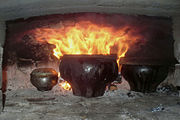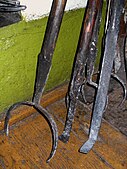
A forge is a type of hearth used for heating metals, or the workplace (smithy) where such a hearth is located. The forge is used by the smith to heat a piece of metal to a temperature at which it becomes easier to shape by forging, or to the point at which work hardening no longer occurs. The metal is transported to and from the forge using tongs, which are also used to hold the workpiece on the smithy's anvil while the smith works it with a hammer. Sometimes, such as when hardening steel or cooling the work so that it may be handled with bare hands, the workpiece is transported to the slack tub, which rapidly cools the workpiece in a large body of water. However, depending on the metal type, it may require an oil quench or a salt brine instead; many metals require more than plain water hardening. The slack tub also provides water to control the fire in the forge.

A wok is a deep round-bottomed cooking pan of Chinese origin. It is believed to be derived from the South Asian karahi. It is common in Greater China, and similar pans are found in parts of East, South and Southeast Asia, as well as being popular in other parts of the world.

A griddle, in the UK typically referred to simply as a frying pan or flat top, is a cooking device consisting mainly of a broad, usually flat cooking surface. Nowadays it can be either a movable metal pan- or plate-like utensil, a flat heated cooking surface built into a stove or kitchen range, or a compact cooking machine with its own heating system attached to an integrated griddle acting as a cooktop.

Cookware and bakeware is food preparation equipment, such as cooking pots, pans, baking sheets etc. used in kitchens. Cookware is used on a stove or range cooktop, while bakeware is used in an oven. Some utensils are considered both cookware and bakeware.

Outdoor cooking is the preparation of food in the outdoors. A significant body of techniques and specialized equipment exists for it, traditionally associated with nomadic cultures such as the Berbers of North Africa, the Arab Bedouins, the Plains Indians, pioneers in North America, and indigenous tribes in South America. These methods have been refined in modern times for use during recreational outdoors pursuits, by campers and backpackers.
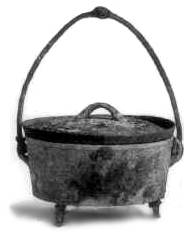
A Dutch oven or casserole dish (international) is a thick-walled cooking pot with a tight-fitting lid. Dutch ovens are usually made of seasoned cast iron; however, some Dutch ovens are instead made of cast aluminum, or ceramic. Some metal varieties are enameled rather than being seasoned, and these are sometimes called French ovens. The international name casserole dish is from the French casserole which means "cooking pot". They are similar to both the Japanese tetsunabe and the sač, a traditional Balkan cast-iron oven, and are related to the South African potjie, the Australian Bedourie oven and Spanish cazuela.

A samovar is a metal container traditionally used to heat and boil water. Although originating in Russia, the samovar is well known outside of Russia and has spread through Russian culture to other parts of Eastern Europe, as well as Western and Central and South Asia. Since the heated water is typically used to make tea, many samovars have a ring-shaped attachment around the chimney to hold and heat a teapot filled with tea concentrate. Though traditionally heated with coal or kindling, many newer samovars use electricity to heat water in a manner similar to an electric water boiler. Antique samovars are often prized for their beautiful workmanship.
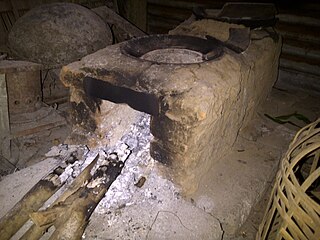
A stove or range is a device that generates heat inside or on top of the device, for local heating or cooking. Stoves can be powered with many fuels, such as electricity, natural gas, gasoline, wood, and coal.

A kettle, sometimes called a tea kettle or teakettle, is a device specialized for boiling water, commonly with a lid, spout, and handle. There are two main types: the stovetop kettle, which uses heat from a hob, and the electric kettle, which is a small kitchen appliance with an internal heating element.

A mess kit is a collection of silverware and cookware designed for use by military personnel for food and military rations. They may also be used during camping and backpacking. There are many varieties of mess kits that militaries issue to their personnel that later become available to consumers.

Induction cooking is performed using direct electrical induction heating of cooking vessels, rather than relying on indirect radiation, convection, or thermal conduction. Induction cooking allows high power and very rapid increases in temperature to be achieved: changes in heat settings are instantaneous.

Heavy-duty cookware made of cast iron is valued for its heat retention, durability, ability to maintain high temperatures for longer time duration, and non-stick cooking when properly seasoned. Seasoning is also used to protect bare cast iron from rust. Types of cast iron cookware include frying pans, dutch ovens, griddles, waffle irons, flattop grills, panini presses, crepe makers, deep fryers, tetsubin, woks, potjies, and karahi.

A pellet stove is a stove that burns compressed wood or biomass pellets to create a source of heat for residential and sometimes industrial spaces. By steadily feeding fuel from a storage container (hopper) into a burn pot area, it produces a constant flame that requires little to no physical adjustments. Today's central heating systems operated with wood pellets as a renewable energy source can reach an efficiency factor of more than 90%.

A masonry heater is a device for warming an interior space through radiant heating, by capturing the heat from periodic burning of fuel, and then radiating the heat at a fairly constant temperature for a long period. Masonry heaters covered in tile are called cocklestoves. The technology has existed in different forms, from back into the Neoglacial and Neolithic periods. Archaeological digs have revealed excavations of ancient inhabitants utilizing hot smoke from fires in their subterranean dwellings, to radiate into the living spaces. These early forms have evolved into modern systems.

Tatar cuisine is primarily the cuisine of the Volga Tatars, who live in Tatarstan, Russia, and surrounding areas.

The Russian stove is a type of masonry stove that first appeared in the 15th century. It is used both for cooking and domestic heating in traditional Russian, Ukrainian, Romanian and Belarusian households. The Russian stove burns firewood or wood manufacturing waste.

A kazan or qazan is a type of large cooking pot used throughout Central Asia, Afghanistan, Armenia, Azerbaijan, Turkey, and the Balkan Peninsula, roughly equivalent to a cauldron, boiler, or Dutch oven. They come in a variety of sizes, and are often measured by their capacity, such as "a 50-litre kazan". Usually their diameter is half a meter. Kazans are made of cast iron or in modern times aluminum and are used to cook a wide variety of foods, including plov (pilaf), sumalak, shorpa, kesme, and bawyrsaq, and as such are an important element in celebrations when food must be prepared for large numbers of guests.
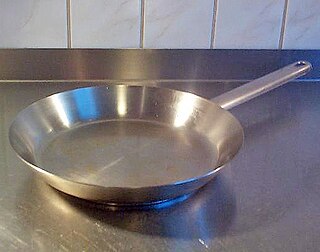
A frying pan, frypan, or skillet is a flat-bottomed pan used for frying, searing, and browning foods. It is typically 20 to 30 cm in diameter with relatively low sides that flare outwards, a long handle, and no lid. Larger pans may have a small grab handle opposite the main handle. A pan of similar dimensions, but with less flared, more vertical sides and often with a lid, is called a sauté pan. While a sauté pan can be used as a frying pan, it is designed for lower heat cooking.
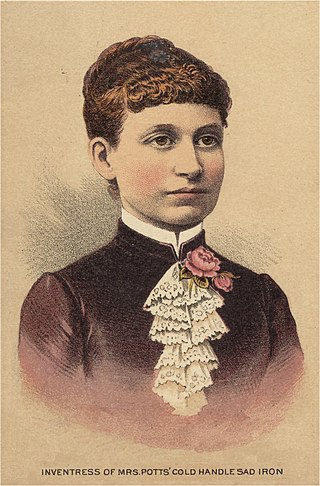
Mary Florence Potts was an American businesswoman and inventor. She invented clothes irons with detachable wooden handles, and they were exhibited at the 1876 Philadelphia Exposition World's Fair and the 1893 Chicago World's Fair. Her inventions were prominent throughout North America and the European continent in the 20th century and became the most popular heavy metal irons ever made.

